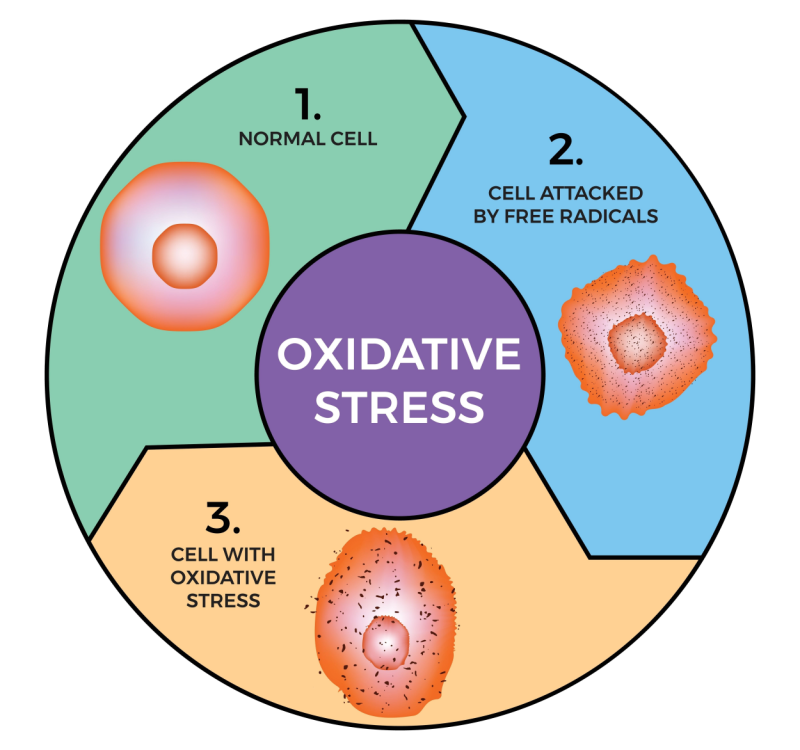
We have always believed that our health and well-being are a result of the symphony played by our organs working together in harmony. Under the direction of the brain, the conductor, our body creates the magical melody of human wellness. But with scientific advances, we have now gained evidence on the dominant role played by genetic expressions and the critical information carried by the messaging services to make them work. True magic happens at a cellular level. But how does it all happen? Is there a way to reverse oxidative stress?

But first... Let's Understand what happens at the Cellular Level
One of the key elements of a typical cell is the mitochondria. Mitochondria is a complex structure within the cell, and it even has its own DNA. Every cell within the body, except red blood cells, has mitochondria. One of the main functions of mitochondria is energy production; it is the powerhouse of the cell. Its main role is to convert Adenosine diphosphate (ADP) to Adenosine Tri-Phosphate (ATP), and in the process, it releases energy. This process helps us to do everything that needs energy, right from pressing our fingers on a keyboard to running and exercising. There is no doubt that what mitochondria do is essential to our survival. But every single time the mitochondria produce ATP, they also release redox signalling molecules. Redox signalling molecules have long been discarded as nothing but a waste product; it turns out that they are anything but a waste product. They are the "fountains of youth."
Let's understand Redox Signaling Molecules Deeper
The phrase comprises the words "Redox" and "signaling molecules." Let's take them one at a time. Redox (short for reduction-oxidation reaction) is a chemical reaction in which the oxidation states of atoms (the building blocks of a molecule) are changed. Any such reaction involves both a reduction process and a complementary oxidation process, two key concepts involved with electron transfer processes. In short, they affect chemical transformation, which involves the transfer of an electron. Signaling molecules, on the other hand, are molecules that cells use to "talk" to each other through a process called cell signaling. This allows the cells to cooperate and coordinate to make complex physiological processes possible. One of the important roles of cellular signaling is to stimulate genetic expression by stimulating genetic pathways. Not the kind of gene expression that dictates how tall you are or which parent you look like, though that is, of course, a part of genetics. The gene expression pathways we’re talking about right now are the communication lines that carry life-sustaining instructions from our genes to our cells. The cells can then carry out these instructions and keep us alive and healthy. Cell signaling molecules have been demonstrated to benefit gene expression pathways in the following body systems:
- immune system;
- hormone modulation;
- inflammatory response;
- digestive function;
- musculoskeletal health;
- cardiovascular health;
- endocrine (hormonal) health;
- skin health;
- brain/nerve health;
- digestive health;
- respiratory health.

So, what exactly is Redox Signaling?
Redox signaling is one of the processes by which cells send and receive chemical instructions from each other. This enables the cells to work together, making complex physiological phenomena like movement, vision, digestion, etc., possible. Redox signaling is so vital to our being that if it gets disrupted, many of our physiological processes would start falling almost immediately. Redox signaling molecules are produced within every cell in our body and act either as cellular activators (reduced species, or RS) or cellular messengers (reactive oxidative species, or ROS).
Cellular Activator (Reduced Species or RS)
Let's have the same exercise again. In the word "Reduced Species," "reduced" denotes the state of the activator. This "reduced" state of this species helps in "activating" antioxidants. While the word "species" denotes the variety of molecules that "activate" antioxidants, the activator molecules carry the messages that tell your cells to activate antioxidants stored in your body. Please note that no amount of additional antioxidants, whether natural or supplemented, can produce the desired effect unless "activated." Antioxidants are chemicals (both naturally occurring and man-made) that keep free radicals in check. Free radicals are positively charged and chemically unstable particles that are in dire need to bind themselves to anything they lay their hands on by stealing an electron. This is bad for biological systems such as ourselves, as free radicals can enter our cells and randomly bind to any biomolecule, causing oxidation. In an ideal scenario, a cell should be able to produce enough cellular activators, or RS, to "activate" sufficient antioxidants to neutralize free radicals. An absence of this would lead to oxidative stress or cellular damage. Depending upon which cell is compromised and how high the damage is, the result could be any ailment ranging from mild inflammation to even cancer (in the case of a compromise to the genetic structure).
Cellular Messengers (Reactive Oxidative Species or ROS)
Reactive Oxidative Species, or ROS, are in a way free radicals themselves, but with a very different role. As the name suggests, these are oxidizing agents that act as messengers to the immune system. Without ROS, our body's immune system has no mechanism to identify oxidative stress or a localized problem it should address. An abundance of ROS in a cellular vicinity indicates "time to act" on the immune system. These messenger molecules are responsible for enabling proper cell communication within our body to ensure the optimal performance of the immune system. They activate our body's immune system to protect against bacteria, viruses, and infection.
Wellness is a Result of Pro-oxidant and Antioxidant Balance
Our health depends on the balance between oxidative stress and antioxidant defenses. Oxidative stress creates an imbalance between pro-oxidants and antioxidant systems in our bodies. An imbalance can be a result of several environmental factors, such as exposure to pollutants, infections, a poor diet, toxins, and radiation. To counter this, our body utilizes redox signaling to communicate and to help maintain a healthy balance between pro-oxidants and antioxidants.
Redox Signalling Molecules Regulate our Immune System
Redox signaling molecules support crucial immune system functions as well as cell renewal and healing at every age. They play very crucial roles in:
- killing pathogens inside the body by destroying infected body cells;
- triggering and shaping the immune response of the body against infections;
- initiating and regulating cellular repair and restoration.

Redox signaling is responsible for maintaining our health and wellness at the molecular level. Without it, life wouldn't have been possible at all! However, our ability to utilize redox molecules becomes less efficient as we age. Science shows that our diets, our environment, or just getting older can turn off genes or lower their activity (downregulation) in the body. The genes that are responsible for redox signaling in our body are also downregulated. Thus, as we age, stress and environmental toxins inundate our lives and weaken our defenses. The effect on each individual could differ, even under similar environmental and socio-cultural factors, due to various reasons. But the result is always detrimental, and it shows through different health ailments.
Bio-Individuality and Redox Signalling
An individual’s cell redox potential affects the bio-mechanism of gene expression. In other words, with efficient redox signaling, genes can express the necessary molecules for homeostatic balance by either replacing, recycling, or repairing a damaged cell. The importance of this cannot be overstated: the cellular redox signaling process enables the cells to detect the damage and start the repair and replacement mechanisms in the mitochondria, including autophagy, which is the process of removing and recycling older mitochondria that are broken, or it is a way to reverse oxidative stress. This process removes poorly functioning mitochondria without killing the cell. This process occurs most often during sleep. Apoptosis is a process of cell death or cell suicide. Normally, apoptosis should begin within two hours following the detection of too high levels of oxidants in the cell, but sometimes this process may be broken, for example, in cancer.
In cancer, apoptosis does not occur, allowing cancer cells to become immortal and spread across the body which eventually may lead to death. Due to various environmental and genetic factors, each one of us starts developing our bio-individual patterns of redox signaling and methods to reverse oxidative stress. These unique patterns may lead to various kinds of health concerns, ranging from premature aging and skin ailments to diabetes, heart diseases, and even cancer. Thus, creating an environment of well-being for our redox molecules could be a potential weapon in the armory.


.png)


